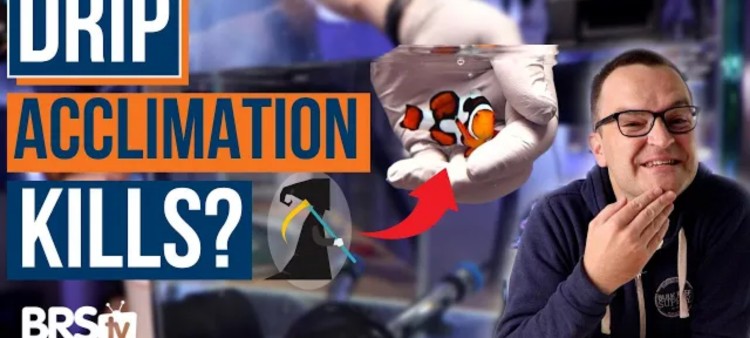A Beginner's Guide to Drip Acclimating New Saltwater Fish
- Jun 04, 2022
- Anshika Mishra
- 583 0 0

Several hobbyists firmly believe we shouldn't drip acclimate fish for reasons we will elucidate shortly. But, the method discussed in this article has testified to its credibility of being the best method to drip acclimate.
Why Do We Drip Acclimate Fish?
The simple answer is that the water from your local fish store or the container it was used to ship in has different water parameters than the water in your home aquarium.
And if you plop new fish into your quarantine tank, the differences in temperature, pH, and salinity can shock the fish, which leads to stress and often lead to disease and death.
So, drip acclimation gives your fish the time to adjust to the new water parameters in the quarantine tank.
Note: You never place new fish in your display tank. You're only going ever to consider putting them in the quarantine tank.
What about inverts such as shrimp, snails, and conches?
It turns out they are even more sensitive, especially to salinity changes. So, drip acclimation is super crucial for them.
Should We Drip Acclimate?
Those who say we shouldn't drip acclimate are still a tiny minority in the hobby.
However, when you purchase a fish online, the retailer will fill the bag part way with water and the rest with pure oxygen. Thus giving the fish enough O2 to survive. During this shipping process, the fish will breathe and excrete, which will increase the ammonia levels and the carbon-di-oxide levels inside that bag.
Ammonia is super toxic to your fish. But as the fish breathes in the bag, the carbon dioxide level build-up, which lowers the pH, means that the Ammonia remains in a non-toxic form.
As soon as you open it, the carbon-di-oxide is released, and oxygen begins to flood in. That oxygen will raise the pH inside the bag. A rapid rise in the pH means that the previously non-toxic Ammonia is changed into its toxic form and could very quickly damage the guilt issue on that fish, causing death.
But, how quickly the toxicity of the Ammonia increases depends on a lot of factors, including how much Ammonia was in the bag, how fast the oxygen enters the water, and how quickly the pH rises.
This is why you often hear that you should never add air stone in the process. It will increase the surface agitation, letting the oxygen enter the water quicker, increasing the toxicity of the Ammonia.
Therefore, for now, the prevailing wisdom still says that the benefits of drip acclimation far outweigh the risks of ammonia toxicity.
Three-Step Drip Acclimation Process
Here is the nine-step Drip Acclimation Process
Step 1: Inspect Livestock
This is only if you have purchased the fish online. So, if you have got it from your local fish store, skip over step 2.
Start by dimming the room's lights before you open up the box. The fish has been in a completely black box for at least a few hours. So, if you open them up to a very bright room, it can stress them out.
So, just dimming those lights down before you open the box can help reduce the stress. Then, when you open the box, make a mental note of the temperature.
Pull out each bag and inspect the livestock to make sure it is alive and looks healthy.
If there's a highly sick fish or a dead fish, stop what you are doing, take pictures immediately, and don't open the bag because an open bag signals to the online retailer that you may have done something to kill the fish.
Make sure to send the picture of the dead fish in the email to the supplier.
However, if everything looks great, its time to move on to step two:
Step 2:Temperature Acclimation
Start by dimming or turning off the lights in your quarantine tanks. Then you want to float the bag over your tank. Be careful not to cover up the weirs.
Float the livestock for about 15-30 minutes. The goal here is to make the temperatures inside the bag match the temperature inside your quarantine tank.
Sometimes, unfortunately, the livestock arrives in terrible shape. So, you can temperature acclimate those fish for a longer if you want to, because sometimes, just increasing or decreasing the water inside the bag can bring those fish back to life.
Note: Do not open the bag at all during the process. Remember, we want to keep the carbon dioxide in that bag, so the pH stays low. As soon as we open that bag, we risk ammonia toxicity, killing the fish.
Step 3: Empty Water/Livestock Into a Bucket
Cut open the bag, and empty the water and the livestock into a bucket. You want to make sure that either you have a small bucket or maybe title the bucket on its side so that there is enough water in the bottom for the fish.
Note: Make sure the bag is inside the bucket. Because as soon as you cut the top of the bag, all of that air will come out of it, and the bag will lose its shape. This way, the bag can easily fall off your hand and onto the floor or maybe injure the livestock.
When pouring the water into the bucket, make sure you are doing it as close to the bottom of the bucket as possible. Doing it from up high could injure the fish as it might hit the bottom of the bucket when you pour it. Also, it would help if you made sure that the fish did not get caught in the bag.
This happens because the fish does not want to get poured out. So, it can get stuck at the bottom of the bag, which can lead to a lot of stress and maybe even death of the fish.






About author